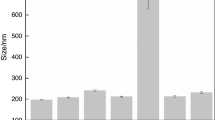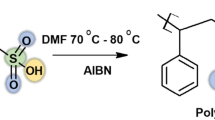Abstract
The study investigates the temporal performance of heat pipe using surfactant free Al2O3/De-ionised water nanofluids. The nanofluids prone to agglomeration and sedimentation with time are expected to influence the performance of heat pipe. Specially fabricated heat pipe is made to accommodate vapor velocity fluctuation through the vapor core and the end cap brazing effects. The heat pipe filled up to 40 % of the evaporator volume is tested at increasing volume concentration (0.005, 0.05, 0.5, 1 vol%) of Al2O3/De-ionised water nanofluid. The thermal performance of heat pipe is tested at three watt loads of heat input (12, 32, 72 W) and after successive durations (0, 3, 6, 9 months) from the date of manufacturing with non operational time span. The results are compared after successive time intervals and with deionised water as working fluid. Despite higher thermal performance of heat pipe observed using nanofluids as working fluids, consistency and reliability in heat pipe operating characteristics has been observed at high watt load heat input of 72 W as compared to low watt heat of 12 W. The thermal performance improvement of heat pipe using the nanofluid resulted due to nano-coating of Al2O3 nanoparticles on the mesh, resulting in localized high vapor pressure caused by the subsequent intermittent accelerated flow, reduction of contact angle and enhancement in boiling limit.












Similar content being viewed by others
Abbreviations
- Qin :
-
Heat input (W)
- q:
-
Heat flux (W/m2)
- β:
-
Line broadening at FWHM (radians)
- T:
-
Temperature (°C)
- R:
-
Thermal resistance (°C/W)
- K:
-
Thermal conductivity (W/m K)
- DI:
-
Deionized water
- Av :
-
Cross-sectional area of vapor core (m2)
- Aw :
-
Cross-sectional area of wick (m2)
- Lt :
-
Total length of the heat pipe (m)
- ρv :
-
Density of vapor (kg/m3)
- ρl :
-
Density of working fluid (kg/m3)
- ɛw :
-
Porosity of wick (dimensionless)
- M:
-
Mass of working fluid (kg)
- avg:
-
Average
- bf :
-
Base fluids
- C:
-
Condenser
- E:
-
Evaporator
- nf :
-
Nanofluids
References
Bejan A, Kraus A (2003) Heat Transfer Handbook. John Wiley & Sons, New York
Fagri A (2012) Review and advances in heat pipe science and technology. ASME J Heat Transf 134(123001):1–18
Choi SUS (1995) Enhancing thermal conductivity of fluids with nanoparticles. ASME FED 231:99–105
Bahrami M, Yovanovich MM, Culham JR (2007) Assessment of relevant physical phenomena controlling thermal performance of nanofluids. AIAA J Thermophys Heat Transf 21(4):673–680
Weerapun D, Somchai W (2007) A critical review of convective heat transfer of nanofluids. Renew Sustain Energy Rev 11:797–817
Keblinski P, Eastman JA, Cahill DG (2005) Nanofluids for thermal transport. Mater Today 8(6):36–44
Wang XQ, Mujumdar AS (2007) Heat transfer characteristics of nanofluids: a review. Int J Therm Sci 46:1–19
Cheng LX, Bandarra F, Thome PE, John R (2008) Nanofluid two-phase flow and thermal physics: a new research frontier of nanotechnology and its challenges. J Nanosci Nanotechnol 8:3315–3332
Eastman JA, Choi SUS, Li S, Yu W, Thompson LJ (2001) Anomalously increased effective thermal conductivities of ethylene glycol-based nanofluids containing copper nanoparticles. Appl Phys Lett 78:718–720
Li CH, Peterson GP (2006) Experimental investigation of temperature and volume fraction variations on the effective thermal conductivity of nanoparticles suspensions (nanofluids). J Appl Phys 99(8):084314
Xuan Y, Li Q (2003) Investigation on convective heat transfer and flow features of nanofluids. J Heat Transf 125:151–155
Heris S, Etemad S, Esfahany M (2006) Experimental investigation of oxide nanofluids laminar flow convective heat transfer. Int Commun Heat Mass Transf 33:529–535
Das SK, Putra N, Thiesen P, Roetzel W (2003) Temperature dependence of thermal conductivity enhancement for nanofluids. J Heat Transf 125:567–574
Buongiorno J, Venerus DC, Prabhat N, McKrell T, Townsend J, Christianson R, Tolmachev YV, Keblinski P, Hu LW, Alvarado JL, Bang IC, Bishnoi SW, Bonetti M, Botz F, Cecere A, Chang Y, Chen G, Chen H, Chung SJ, Chyu MK, Das SK, Paola RD, Ding Y, Dubois F, Dzido G, Eapen J, Escher W, Funfschilling D, Galand Q, Gao J, Gharagozloo PE, Goodson KE, Gutierrez JG, Hong H, Horton M, Hwang KS, Iorio CS, Jang SP, Jarzebski AB, Jiang Y, Jin L, Kabelac S, Kamath A, Kedzierski MA, Kieng LG, Kim C, Kim JH, Kim S, Lee SH, Leong KC, Manna I, Michel B, Ni R, Patel HE, Philip J, Poulikakos D, Reynaud C, Savino R, Singh PK, Song P, Sundararajan T, Timofeeva E, Tritcak T, Turanov AN, Vaerenbergh SV, Wen D, Witharana S, Yang C, Yeh WH, Zhao XZ, Zhou SQ (2009) A benchmark study on the thermal conductivity of nanofluids. Journal of Applied Physics 106:094312-1–094312-14
Kang SW, Wei WC, Tsai SH, Yang SU (2006) Experimental investigation of silver nanofluid on heat pipe thermal performance. Appl Therm Eng 26:2377–2382
Tsai CY, Chein HT, Ding PP, Chan B, Luh TY, Chen PH (2004) Effect of structural character of gold nanoparticles in nanofluid on heat pipe thermal performance. Mater Lett 58:1461–1465
Naphon P, Thongkum D, Assadamongkol P (2009) Heat pipe efficiency enhancement with refrigerant-nanoparticles mixtures. Energy Convers Manag 50:772–776
Kole M, Dey TK (2013) Thermal performance of screen mesh wick heat pipes using water-based copper nanofluids. Appl Therm Eng 50:763–770
Noie SH, Heris SZ, Kahani M, Nowee SM (2009) Heat transfer enhancement using Al2O3–water nanofluid in a two phase closed thermo-syphon. Int J Heat Fluid Flow 30(4):700–705
Hung YH, Teng TP, Lin BG (2013) Evaluation of the thermal performance of a heat pipe using alumina nanofluids. Exp Therm Fluid Sci 44:504–511
Saleh R, Putra N, Prakoso PS, Septiadi WN (2013) Experimental investigation of thermal conductivity and heat pipe thermal performance of ZnO nanofluids. Int J Therm Sci 63:125–132
Asirvatham LG, Nimmagadda R, Somchai Wongwises S (2013) Heat transfer performance of screen mesh wick heat pipes using silver–water nanofluid. Int J Heat Mass Transf 60:201–209
Chen Y-T (2010) Experimental study of silver nanofluid on flat heat pipe thermal performance. J Mar Sci Technol 18(5):731–734
Suresh Kumar R, Tharves Mohideen S, Nethaji N (2013) Heat transfer characteristics of nanofluids in heat pipes: a review. Renew Sustain Energy Rev 20:397–410
Kumaresan G, Venkatachalapathy S, Asirvatham LG (2014) Experimental investigation on enhancement in thermal characteristics of sintered wick heat pipe using CuO nanofluids. Int J Heat Mass Transf 72:507–516
Dhawan N, Gangacharyulu D, Bulasara VK (2015) Experimental studies on entrainment characteristics of alumina–water nanofluids. M.Tech. thesis, Department of Chemical Engineering, Thapar University, Patiala, India. http://dspace.thapar.edu:8080/dspace/handle/10266/3678
Nagasaka Y, Nagashima A (1981) Absolute measurement of the thermal conductivity of electrically conducting liquids by the transient hot wire method. J Phys E Sci Instrum 14:1435–1440
Chi SW (1976) Heat pipe theory and practice: a sourcebook. Hemisphere Publishing Corporation, Washington, DC
Acknowledgments
The author gratefully acknowledges the support provided by management of Thapar University, Patiala and Indian Institute of Technology for providing the necessary facilities to carry out this research work.
Author information
Authors and Affiliations
Corresponding author
Rights and permissions
About this article
Cite this article
Bhullar, B.S., Gangacharyulu, D. & Das, S.K. Temporal deterioration in thermal performance of screen mesh wick straight heat pipe using surfactant free aqueous nanofluids. Heat Mass Transfer 53, 241–251 (2017). https://doi.org/10.1007/s00231-016-1785-6
Received:
Accepted:
Published:
Issue Date:
DOI: https://doi.org/10.1007/s00231-016-1785-6




